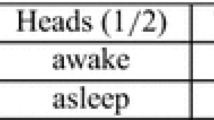Abstract
In the Sleeping Beauty problem, Beauty is woken once if a coin lands heads or twice if the coin lands tails but promptly forgets each waking on returning to sleep. Philosophers have divided over whether her waking credence in heads should be a half or a third. Beauty has centered beliefs about her world and about her location in that world. When given new information about her location she should update her worldly beliefs before updating her locative beliefs. When she conditionalizes in this way, her credence in heads is a half before and after being told it is Monday. In applications of Dutch Book arguments to the Sleeping Beauty problem, the probability of a particular outcome has often been confounded with consequences of that outcome. Heads and tails are equally likely but twice as much is at stake if the coin falls tails because Beauty is fated to make the same choice twice. As a consequence, the possibility of tails should be given twice the weight of the possibility of heads when deciding whether to bet on heads even though heads and tails are equally likely.

Similar content being viewed by others
Notes
Locative beliefs are de se beliefs. Worldly beliefs are not otherworldly beliefs. They are Beauty’s centered beliefs about her actual world and what it might be. If her actual world is conceived as an object with properties, then worldly beliefs might be considered de re (but I am ill-educated on the philosophical nuances of these Latin phrases).
Lewis (1979) might have said that when Beauty is told it is Monday, she learns something about her location in ordinary space that changes her location in logical space. Her propositional attitude changes from ‘week in which heads or tails’ to ‘Monday in which heads or tails.’ ‘Waking on Tuesday’ is a property of the first propositional attitude that does not have a counterpart in the second propositional attitude.
This procedure appears similar to, perhaps is the same as, Meacham’s (2008, p. 249) compartmentalized conditionalization.
References
Allen B, Nowak MA, Wilson EO (2013) Limitations of inclusive fitness. Proc Natl Acad Sci USA 110:20135–20139
Arntzenius F (2002) Reflections on Sleeping Beauty. Analysis 62:53–62
Bostrom N (2007) Sleeping beauty and self-location: a hybrid model. Synthese 157:59–78
Bradley D, Leitgeb H (2006) When betting odds and credences come apart: more worries for Dutch book arguments. Analysis 66:119–127
Briggs R (2010) Putting a value on beauty. Oxf Stud Epistem 3:3–34
Elga A (2000) Self-locating belief and the Sleeping Beauty problem. Analysis 60:143–147
Haig D (1997) Parental antagonism, relatedness asymmetries, and genomic imprinting. Proc R Soc B 264:1657–1662
Haig D (2000) Genomic imprinting, sex-biased dispersal, and social behavior. Ann NY Acad Sci 907:149–163
Haig D (2006) Intragenomic politics. Cytogenet Genome Res 113:68–74
Haig D (2012) The strategic gene. Biol Philos 27:461–479
Haig D (2013) Filial mistletoes: the functional morphology of moss sporophytes. Ann Bot 111:337–345
Haig D, Westoby M (1989) Parent-specific gene expression and the triploid endosperm. Am Nat 134:147–155
Hitchcock C (2004) Beauty and the bets. Synthese 139:405–420
Law R, Cannings C (1984) Genetic analysis of conflicts arising during development of seeds in the Angiospermophyta. Proc R Soc B 221:53–70
Lewis D (1979) Attitudes de dicto and de re. Philos Rev 88:513–543
Lewis D (2001) Sleeping Beauty: reply to Elga. Analysis 61:171–176
Liao X, Rong S, Queller DC (2015) Relatedness, conflict, and the evolution of eusociality. PLoS Biol 13:e1002098
Meacham CJG (2008) Sleeping beauty and the dynamics of de se beliefs. Philos Stud 138:245–269
Queller DC (1983) Kin selection and conflict in seed maturation. J Theor Biol 100:153–172
Queller DC (1984) Models of kin selection on seed provisioning. Heredity 53:151–165
Queller DC (1989) Inclusive fitness in a nutshell. Oxford Surv Evol Biol 6:73–109
Westoby M, Rice B (1982) Evolution of the seed plants and inclusive fitness of plant tissues. Evolution 36:713–724
Acknowledgments
Lucas Mix brought the Sleeping Beauty problem to my attention. Carl Veller patiently explained thirder reasoning and critically read the manuscript. Ned Hall and the anonymous reviewers provided valuable input.
Author information
Authors and Affiliations
Corresponding author
Rights and permissions
About this article
Cite this article
Haig, D. Sleeping Beauty in a grain of rice. Biol Philos 31, 23–37 (2016). https://doi.org/10.1007/s10539-015-9503-1
Received:
Accepted:
Published:
Issue Date:
DOI: https://doi.org/10.1007/s10539-015-9503-1



